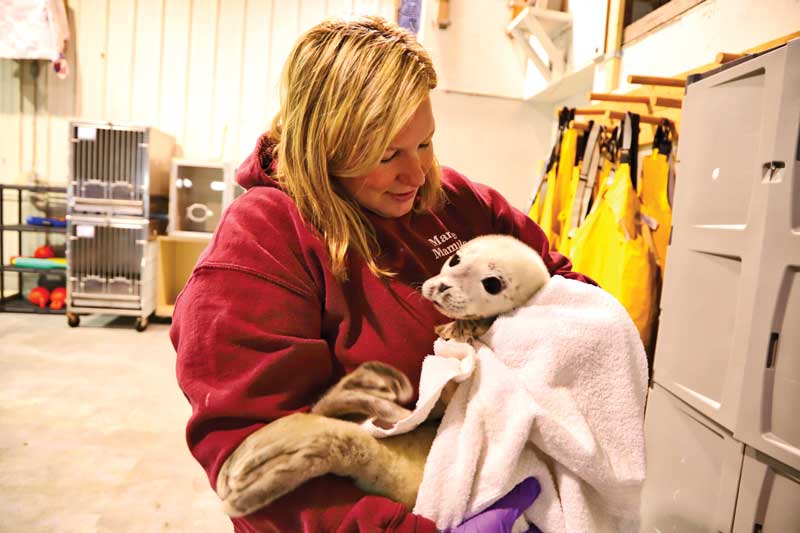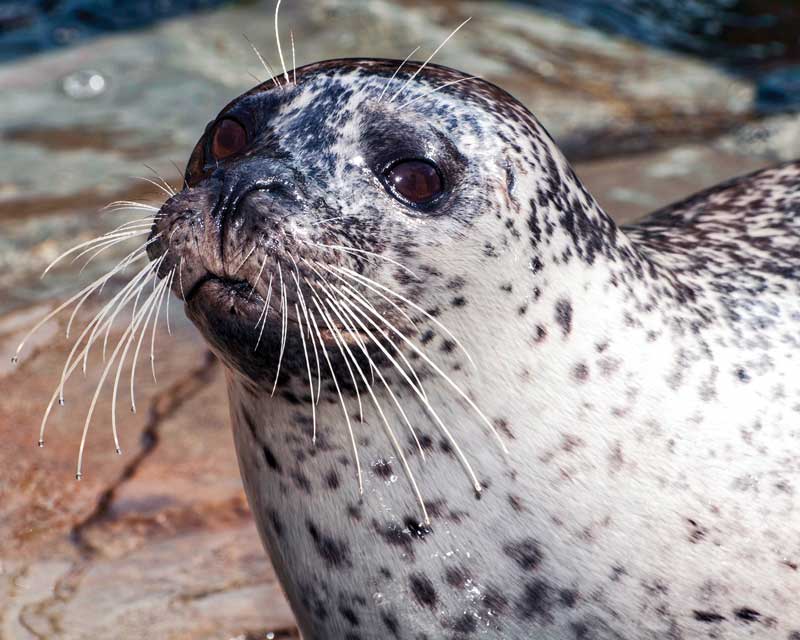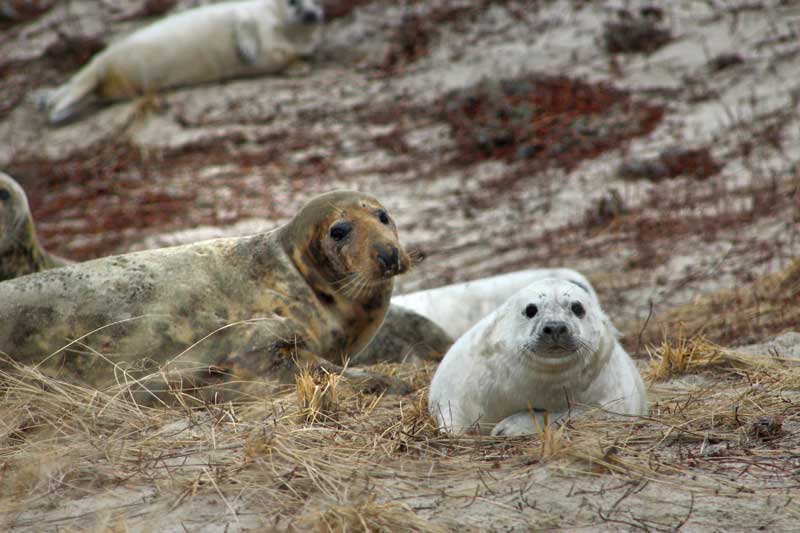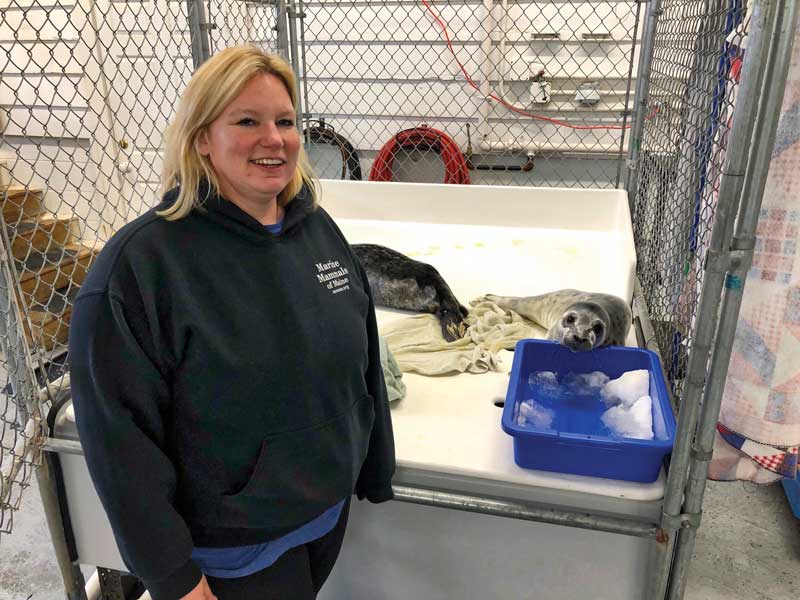 Lynda Doughty has devoted her life to rescuing, caring for, and researching seals in New England and beyond. The Gulf of Maine’s seal population has grown nearly 20-fold since coming under federal protection in 1972. Photo courtesy Marine Mammals of Maine
Lynda Doughty has devoted her life to rescuing, caring for, and researching seals in New England and beyond. The Gulf of Maine’s seal population has grown nearly 20-fold since coming under federal protection in 1972. Photo courtesy Marine Mammals of Maine
When it comes to seals, Lynda Doughty is here, there, and everywhere.
She rescues seals that are sick, injured, or just simply confused from beaches, rocky shores, or even front yards in coastal neighborhoods. She assesses and cares for them in her marine mammal rehabilitation center in Brunswick, the largest of its type in the Northeast, and works with other scientists capturing, testing, and tracking seals from Maine to Virginia.
Doughty has devoted her working life to caring for the charismatic seadogs that, through the years, have become a fundamental piece of Maine’s coastal culture. The organization she founded, Marine Mammals of Maine, has responded to calls for more than 3,500 seals and other marine mammals found stranded or deceased along Maine’s coastline from Kittery to Rockland. Her work earned her a CNN Hero award in 2021.
Doughty discovered her passion for marine mammals while growing up along the shores of Phippsburg. Marine Mammals of Maine, or MMoME, is the centerpiece of her work, with a 24/7 hotline people can call to report marine mammals and sea turtles in need of help. The research that she performs on seals provides valuable information about Maine’s marine mammals, their habitats, and human impacts on their populations.
“One thing I don’t want is to not have a voice for these animals in the state of Maine,” Doughty said while giving a tour of her rehabilitation center, where four gray seal pups were being cared for on that day. “There’s a lot more human interaction with seals on our coastline, and we’re in their natural habitat, so we want to give these animals space, and let seals do what seals do.”
Doughty’s boots-on-the-ground approach gives her a keen understanding of the interaction between seals, humans, and the environment, said Kristina Cammen, an assistant professor of marine mammal science at the University of Maine, who has worked with Doughty on seal research projects.
 Marine Mammals of Maine says it costs $6,000-8,000 to rehabilitate a single seal. Photo by Clarke Canfield
Marine Mammals of Maine says it costs $6,000-8,000 to rehabilitate a single seal. Photo by Clarke Canfield
“She has a dream and she’s going to make that dream a reality,” said Cammen, who also serves on the MMoME board. “Nothing’s going to get in her way. She brings her passion and motivation to those around her and lifts everyone up to make this dream a reality. That dream is to support the coastal ocean health in the Gulf of Maine very broadly.”
Anybody who boats along the coast knows there are lots of seals in Maine waters. Harbor seals are the most common, but larger large gray seals are here year-round as well. Small numbers of harp and hooded seals visit seasonally.
Half a century and more ago, seals were relatively rare in Maine, viewed as fish-gobbling pests that threatened the livelihoods of fishermen. Beginning in Colonial times, communities throughout the region enacted intermittent bounty programs to control the seal population. Maine offered a bounty on seals from 1891-1905 and again from 1937-1945 to reduce their populations to help fish stocks—bounty hunters brought in seal noses to prove their kills. Massachusetts had a seal bounty program until 1962. Records suggest that 70,000 to 135,000 seals were removed from Maine and Massachusetts during the bounty programs.
But times have changed, and the seal numbers have grown in the decades since, coming under federal protection with the 1972 passage of the Marine Mammal Protection Act. Now, there are an estimated 63,000 harbor seals and 27,000 gray seals in Maine during their pupping seasons, up from just 5,000 or so in the early 1970s.
With the population growing, so have reports of seals being stranded or hurt on Maine beaches and rocky shores. On occasion, seal pups are found on streets, in yards, and even on golf courses in coastal communities, confused about what to do after being left by their mothers. This past January, a wayward seal was found flopping on a neighborhood street near Fort Williams Park in Cape Elizabeth, and another was found in somebody’s front yard nearby.
After graduating from high school in 1994, Doughty set out to help marine mammals in any way she could. While seals account for the vast majority of Marine Mammals of Maine’s calls, it also responds to reports of other marine mammals—whales, harbor porpoises, white-sided dolphins—and sea turtles.
Doughty, 46, earned marine biology degrees at Southern Maine Community College and Maine Maritime Academy and got involved with seal research and rescues, for nonprofits and at the Department of Marine Resources. When rescue organizations and state agencies lost funding or closed their doors, she founded her own rescue organization, Marine Mammals of Maine, in 2011. At the time, rescued seals were brought to a seal rehabilitation center at the University of New England, in Biddeford.
When UNE closed its seal unit, she opened a rehabilitation facility of her own, in what had been an empty boathouse in Harpswell. That’s where she operated from 2014 until 2020, when she moved to the spacious building in Brunswick.
On a cold winter day, she gave a tour of the 5,000-square-foot building, where four young seals were being kept. One was brought here from the remote Maine island of Criehaven, one from Cape Cod, and two from Cape Elizabeth.
When they get here, seals are tested for multiple viruses, and blood samples (and possibly blubber samples) are taken. Before they are released into the wild, they have number tags attached to their flippers—although there’s also a temptation to give the animals names because they’re so cute.
“They aren’t here long enough for names, but I can’t say people don’t have their favorites,” Doughty said. “They have their own personalities.”
For the past several years, Doughty has also been part of a team that’s been researching seals off Cape Cod and farther south. The work is headed by Kimberly Murray, who leads the Seal Ecology and Assessment Program at NOAA Fisheries’ Northeast Fisheries Science Center in Woods Hole, Massachusetts. She said Doughty is an invaluable part of the team because of her vast experience handling and testing seals.
“I think what drives her is her love for the animals,” Murray said. “I think that’s the core of it. She’s passionate about the animals and their conservation, and she’s incredibly observant and perceptive. The heart of it is just trying to save the animals.”
For now, Marine Mammals of Maine has grown to six employees, 65 volunteers, and an annual budget of $380,000. Seventy percent of the budget comes from private donations, the other 30 percent from grants.
Without MMoME, who would people call when they come across seals that might be in distress? “That,” Doughty said, “is why we want to be here.”
✮
Clarke Canfield is a longtime journalist and author who has written and edited for newspapers, magazines, and The Associated Press. He lives in South Portland with his wife.
Maine is home to two species of seals:
 Harbor seals are commonly seen resting on rocks and beaches with their head and rear flippers elevated in a banana-like position. Photo courtesy NOAA Fisheries
Harbor seals are commonly seen resting on rocks and beaches with their head and rear flippers elevated in a banana-like position. Photo courtesy NOAA Fisheries
Harbor seals are the most common seals in Maine, numbering about 63,000 during the spring pupping season. Adults grow to be up to 285 pounds and 6 feet long. Males are slightly larger than females, and seals in Alaska and the Pacific Ocean are generally larger than those found in the Atlantic Ocean.
 Gray seals on average eat four to six percent of their body weight in food each day, but do not eat during the mating/pupping or molting seasons. Photo by Kimberly Murray courtesy of NOAA Fisheries
Gray seals on average eat four to six percent of their body weight in food each day, but do not eat during the mating/pupping or molting seasons. Photo by Kimberly Murray courtesy of NOAA Fisheries
Gray seals are most numerous in Canada, but about 27,000 can be found in New England waters during pupping season in December and January. Females grow to be 7½ feet long and up to 550 pounds, while males can grow up to 10 feet long and 880 pounds.
Source: NOAA Fisheries







